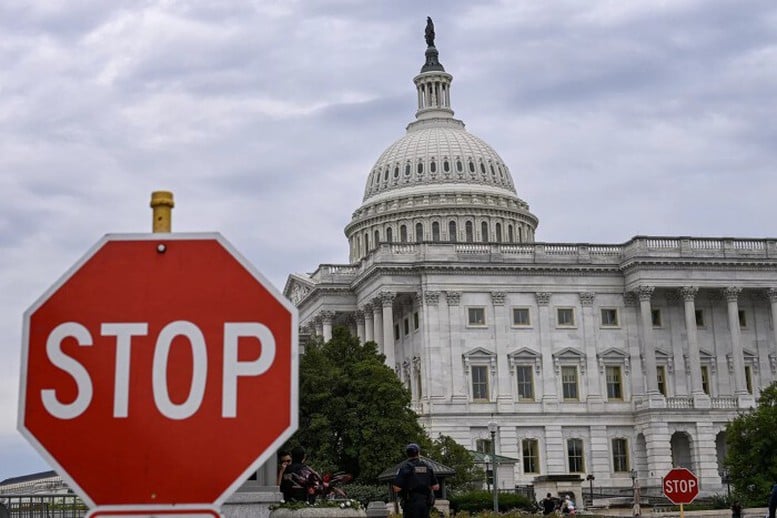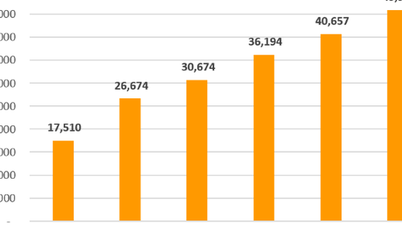
The US government shutdown has entered its third week. (Illustration photo: AFP/Getty Images).
Meanwhile, the Senate reconvened on October 20 and voted for the 11th time to try to end the government shutdown, but failed because it did not have the 60 votes needed to pass a temporary budget bill.
Since the shutdown began, Republicans have not won any new support for the bill, which would fund the government through November 21. However, GOP leaders have recently suggested they could get more support from the opposition, although they would need the support of five more Democrats to overcome the hurdle.
Senate Majority Leader John Thune is also expected to introduce a bill this week to pay federal employees and military personnel who continue to work during the shutdown, but it will still need support from Democrats.
House members are not expected to return to Washington this week as Republican leaders continue to place the onus on reopening the government on the Senate. The House has not voted since September 19, and House Speaker Mike Johnson said he would bring the House back if the Senate votes to pay federal and military workers, but he said that is unlikely.
The US government faces the risk of the longest shutdown in history.
The US government shutdown, initially expected to last only two to three weeks, is now threatening to last until November...
"To reopen the government, either the White House must reach a deal or the Democrats must make concessions. However, there is currently no sign that either will happen. If the shutdown continues, this could become the longest government shutdown in US history," analysts at consulting firm Beacon Policy Advisors said in a recent report.
The US government has been shut down since October 1 due to a stalemate in Congress over a new budget, forcing many federal agencies to temporarily halt operations. As of Monday (October 20), the US government has been shut down for 20 days, while the longest shutdown on record is 34 days, which happened nearly 7 years ago during President Donald Trump's first term.
Last week, Kalshi, a prediction exchange regulated by the US Commodity Futures Trading Commission (CFTC), predicted the government shutdown could last about 41 days, up from the 14-day forecast it made two weeks ago.
The forecast is based on analysis that the November 1, 2025, date for Obamacare open enrollment — when Americans will be able to sign up or change their health insurance plans for the following year — is widely seen as a factor that could spur a deal in Congress.
Energy Secretary Chris Wright said the National Nuclear Security Administration, which manages the US nuclear arsenal, began furloughing "most" employees on October 20, although "mission-critical" employees will remain on the job.
While President Donald Trump signed an executive order directing the Pentagon to ensure pay for active-duty troops despite the shutdown, this does not apply to all other federal employees who are required to stay on the job.
With President Trump leaving the US on October 26 for a five- to six-day visit to several countries in Asia, the shutdown risks lasting longer if a deal is not reached by the end of the week.
Source: https://baochinhphu.vn/chinh-phu-my-dong-cua-that-bai-lan-thu-11-sap-vuot-moc-lich-su-102251021063028727.htm





![[Photo] Prime Minister Pham Minh Chinh received Mr. Yamamoto Ichita, Governor of Gunma Province (Japan)](https://vphoto.vietnam.vn/thumb/1200x675/vietnam/resource/IMAGE/2025/10/21/1761032833411_dsc-8867-jpg.webp)
![[Photo] Da Nang residents "hunt for photos" of big waves at the mouth of the Han River](https://vphoto.vietnam.vn/thumb/1200x675/vietnam/resource/IMAGE/2025/10/21/1761043632309_ndo_br_11-jpg.webp)



















![[Photo] Prime Minister Pham Minh Chinh meets with Speaker of the Hungarian National Assembly Kover Laszlo](https://vphoto.vietnam.vn/thumb/1200x675/vietnam/resource/IMAGE/2025/10/20/1760970413415_dsc-8111-jpg.webp)

















































































Comment (0)